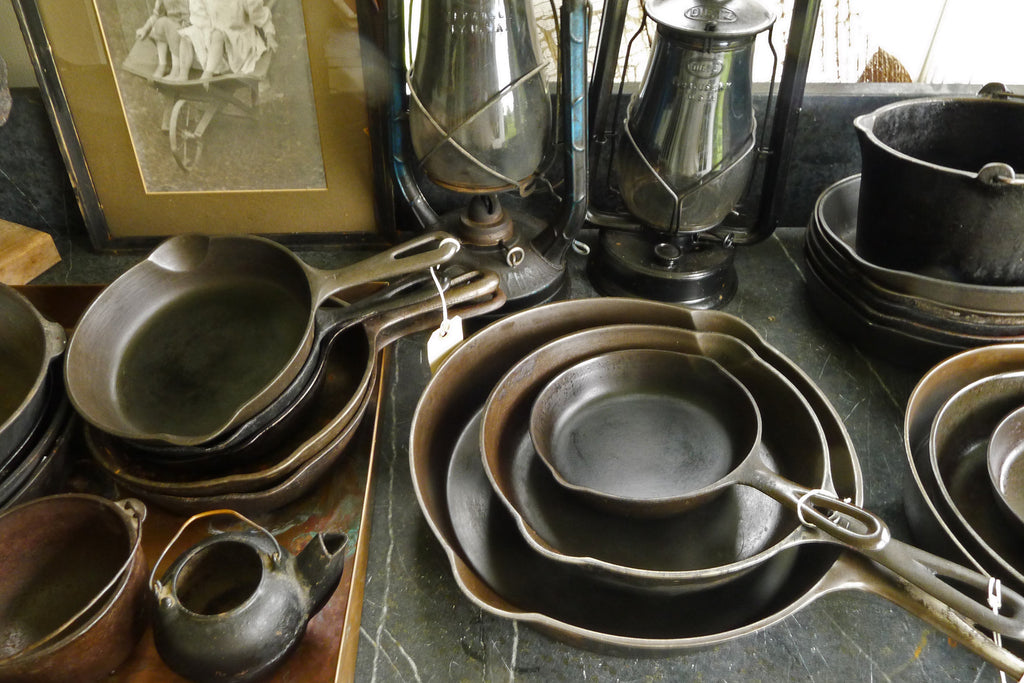

SMOOTH TALK
We delve into the most important attribute of cast-iron cookware.
You hear us talking pretty often about one particular word. We extoll its virtues when we speak of cooking, and cleaning, and seasoning, and what sets our pans apart. But while it sounds nice, like a dog’s coat or a suede jacket, there’s a good chance that you have no idea why we won’t stop yammering on about smoothness.
Simply put, smoothness matters.
Let’s begin with the basics: run your hand across the surface of the various pieces of cookware in your kitchen. You’ll notice that each feels a little different, and some more dramatically than others. The base of your copper pots could be like a car windshield, while certain cast irons could feel like an exfoliating trip to the spa. We’re somewhere in the middle, with a touch of our pan’s surface having the slightest reminiscence of velvet. That’s the way the old Griswolds and Wagners and Favorites felt. Buttery, supple—smooth. Like a fine piece of craftsmanship.

Now, why does this matter?
Well, let’s go back to that car windshield. Imagine you’re stuck in the middle of the desert with a broken-down vehicle and nothing to eat but one damn egg. Which would be easier, frying it on the hot glass of your car windshield or the rugged asphalt on which you stand? (We promise: one day, we’re going to actually do this to a prove a point.)
The glass, duh. Because a rough surface has tons of tiny divots for food to creep in and adhere to, whereas a smooth, continuous surface will cook it with far less sticking.
But can’t you achieve the same end with a rough pan if you add enough seasoning? The answer is: sure. With enough fat or oil on top, that desert road could temporarily become a flattop grill, with the food you’re cooking simply floating on, and oftentimes bathing in, those lipids.
Similarly, with enough time and use, layers of seasoning can eventually fill in and level out a sandpapery pan. But it has to be maintained. If you strip off some seasoning, you’re back to that original rough surface, with part of your egg sticking to the grit, and the rest frying perfectly fine on the nice buildup of fat that came with lots of cooking. Do this on an already smooth pan, and it’ll go more, well, smoothly.
Another reason why smoothness matters: it helps build seasoning, too.
Here’s a second analogy: If you buy an old house in need of a touchup, would it be easier to paint fresh lumber or existing siding with its lacquered coats of yore?
The lumber, duh. Lay that color on a smooth surface and it adheres in a uniform fashion. Lay it on something lumpy and it’s prone to peel and chip. And we know nobody, and we mean nobody, enjoys sanding back down to wood.
Speaking of sanding, most cast-iron companies today use a similar process to create their final products. In the industry, the term is known as “machining,” where a coarse surface is machine-milled into something level and flat. Other times, more crudely, they are “hogged out,” where a mass of metal is literally hollowed out to create the shape of a pan, with a lot of material ending up in the trash. We're not naming any names.

When done right, these processes do, in fact, make a smooth surface, but they can also create microscopic crevices, as well as uneven thickness throughout the pan, as easily seen when looking at them (see above). It’s not the end of the world, visually, but this does ultimately create hotspots for cooking, aka those tricky areas of irregular heat transfer that tend to burn your egg yolk before the white is finished cooking or burn your steak before its medium rare. And all the while, the exterior remains rough, which can scratch your stove and counters.
Butter Pats, on the other hand, are cast smooth, on all sides, meaning they come out of the molds as smooth as you receive them—and sometimes even smoother! Which is why we continue to get high scores for even heat and even cooking from the experts that be. Not bragging. Just facts.
Smoothness impacts your cooking. Smoothness impacts your seasoning, which also impacts your cooking. So yes, smoothness matters.
Of course, nothing good ever comes easy. Casting smooth is a difficult process, one perfected over years and inspired by other centuries, when all pans were made this way, which, then as now, was only possible with the human hand. But today, fewer and fewer foundries retain the old know-how to actually do it, which makes the final product—aka our pans—more expensive.

Cheaper is often a byproduct of faster, which does not always mean better, and casting smooth takes time, with modern, machine-made pans taking as little as 90 minutes to make, whereas each one of ours sits in the molds for at least 24 hours, taking 21 days from start to finish. It’s a difference you can literally see, feel, and eventually, taste.
This is why we also encourage you to keep your cast iron clean. You paid a lot of money for us to make a pan this smooth. Help yourself keep it that way, by not leaving behind those extra undulating layers of crud that can come with certain meals.
Use water. Use soap. Dry it off well. Then do it all over again.
Smooth cooking, y’all.



